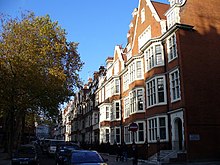
Hornton Street is a street in Kensington, London W8. It runs north to south from Sheffield Terrace to Kensington High Street.
History
Some of the road, at least, was originally called Campden House Road.
A chapel on the corner of Hornton Street and Hornton Place was built in 1794 for Congregationalists on land owned by William Phillimore. By 1858, it became a Baptist chapel. However, it was demolished in 1927.
The street was home to a Nonconformist school until it was torn down in 1868 for the construction of the Metropolitan Railway.
The musician Sir Charles Stanford (1852–1924) lived at No. 56 from 1894 to 1916, and this is commemorated with a blue plaque, erected in 1961.
Many of the houses are listed, including the entire terrace from 12 to 54, built from 1903, and designed by Frank Chesterton; running between Holland Street and Hornton Place, opposite Kensington Town Hall and Kensington Central Library.
References
- "The Pitt estate | British History Online". British-history.ac.uk. Retrieved 1 October 2016.
- ^ Denny, Barbara; Starren, Carolyn (1998). Kensington Past. London, U.K.: Historical Publications. p. 127. ISBN 9780948667503. OCLC 42308455.
- Denny, Barbara; Starren, Carolyn (1998). Kensington Past. London, U.K.: Historical Publications. p. 132. ISBN 9780948667503. OCLC 42308455.
- "STANFORD, Sir Charles (1852-1924)". English Heritage. Retrieved 1 October 2016.
- Historic England. "12-54 Hornton Street W8 (1191596)". National Heritage List for England. Retrieved 29 September 2016.
External links
![]() Media related to Hornton Street at Wikimedia Commons
Media related to Hornton Street at Wikimedia Commons
51°30′14.19″N 0°11′44.27″W / 51.5039417°N 0.1956306°W / 51.5039417; -0.1956306
Categories: